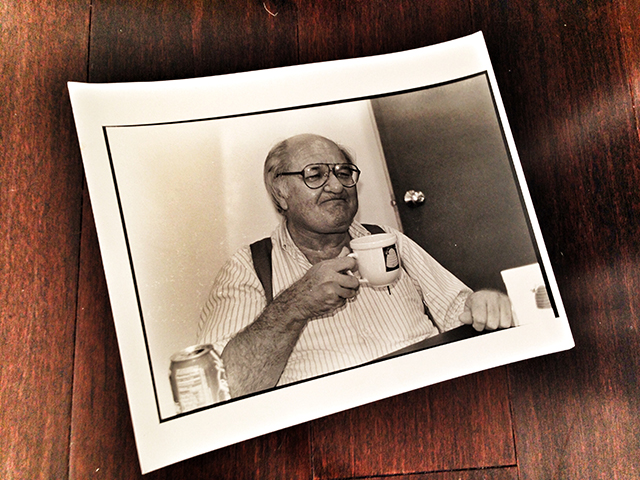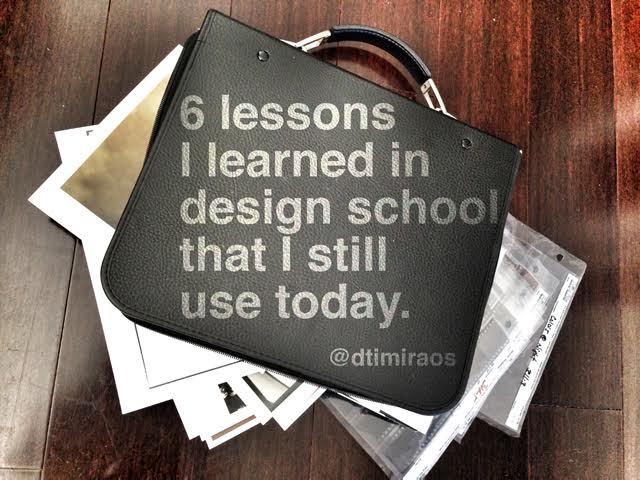This article has been contributed by Daniel TImiraos, a multi-disciplinary creative with over 17 years of agency experience creating design solutions for traditional and interactive media. Enjoy!

It feels like eons ago that I started my art/design education – back before Friends were friends and grunge rock was getting it’s foothold on the main stream. The Apple Macintosh had gotten it’s foothold on all things design, but I still learned how to use a stat machine, create paste-ups and work with Rubylith paper and rub down Letraset type. I can fortunately say that I had an amazing bunch of professors at the School of Arts and Sciences at the University of Miami (Go ‘Canes!).

The entrance to the old Art Department building, which now houses other academic departments at the University of Miami. Many great memories and lessons were had here.
They were great times with great lessons learned. Those lessons are ever-present for me as I use them very often, some almost daily. I hope in reading them they’ll stay with you and be as helpful to you as they’ve been to me. Here are 6 of my favorites:
1) There’s no color like the color you make yourself.

Exposure and color test printing with the obligatory, photo-class self-portrait images.
This lesson was learned when printing my first color photo c-print. It was done with an all-manual color enlarger and filter gels. We were told that once we learned how to control and create our own color prints, we’d never look at the crap that came out of the drugstore photo machine the same again. The professor was absolutely correct! The level of vividness and color accuracy I was able to get, once I figured it out, was amazing. Another truth was that each person interprets what the best or truest color solution for an image is, be it a bit warmer or cooler, his or her own way. So controlling your color is key.
How do I still use this?
The methods have changed but the theory still holds true. Color theory that is. Whether your working in CMYK, RGB or plugging in hexadecimal numbers on the web, understanding how to control your colors within your medium will make a world of difference in your work. All it takes is understanding, and practice, lots of practice.
2) Just do it.

There was always a story to be told with a lesson learned from the late, great Tom Gormley. I’m glad I took this picture of the big guy.
This might belong to Nike but in my world that phrase belonged to Tom Gormley. He’d say that you could only think about something so many times before it went stale. Put it down on paper, take the picture, or draw it out. Just do it. You’ll build from there.
How do I use this?
By just doing it. As creatives we tend to ruminate over our ideas a lot in a vicious circle especially on a new or particularly daunting project. Just do it! That doesn’t mean you jump into a project with zero research or forethought. It means that, based on your thorough research, you put it down on paper or pixel. No matter how large or small, the hardest step to take is always the first one. Take it and the next one will follow. And in doing it you’ll see if the direction is truly correct and if not a new direction will present it self from your findings.
3) You draw with your eyes not your hands.
These simple words of wisdom, still apply. Your hands interpret what the mind visualizes but your eyes are the ones that guide the whole thing. They are managers of the project if you will, assessing and adjusting to get things just the way you want.
How do I still use this?
It’s easy to blindly create a layout or composite an image without really seeing it, especially if you’re bleary-eyed from staring at it for too long. Take a moment in your work to step back and really take a fresh look at what you’re putting together. Walk away from it for a few minutes to make sure that you were really seeing and not just looking at your project. Stay creative.
4) Just because you can, doesn’t mean you should.

One of my first commissioned jobs – creating a poster series using old “Social” magazine covers for The UM Libraries’ Cuban Collection. Instead of retouching out all the stains and creases, they were left in to show the age of the publication.
This came out of a digital imaging/Photoshop class. The professor was very apt to remind us that most images require just enough retouching and knowing when to stop would be one of the most important lessons we’d learn.
How do I use this?
Well, the obvious answer is in my retouching and digital imaging work. When retouching for fashion the flawless look is definitely the way to go but even then, you can take the image too far. The less obvious answer is in everything else I do. You have to know when you’re ready to start and when you’re ready to stop so you don’t over think/design/light/illustrate it.
5) Sometimes you have to dumb it down or if you can’t explain it simply you don’t understand it.
Both of these go together because they came from the same professor and the same lesson. He certainly had a way with words when giving direction on your art projects. He’d say to just dumb it down a bit, meaning, simplify the message. And, if you can’t explain it simply, you certainly don’t understand it. Needless to say it was a tough course! He really hammered home the point the you needed to break it down to its most concise form to makes sure your message gets understood.
How do I still use it today?
This is the golden rule of design and the art of presenting in my opinion. Breaking down an explanation or a design project to it’s simplest parts is quite a feat, but the level of communication you can achieve by doing this will certainly make a difference in getting to your audience. Think of the most powerful taglines and logos out there. They are marvels in their simplicity and concise messaging. And when was the last time that a text and graphics heavy PowerPoint presentation drove the point home for you?
6) There’s the easy way and the right way to do things.

Second and third doors on the left housed the design and print studios. I’d say if those walls could talk, but in a way that’s what this article is doing!
This is another philosophical tidbit that came out of a design class. Just because a design solution is easy to accomplish doesn’t make it the right choice. The opposite holds true as well, just because it overly complex doesn’t make it the most effect solution either.
How do I still use it today?
I use this every single time I tackle a design/art/writing/photo/technical project. It’s not about whether it’s an easy fix or a tedious process but rather how effective a solution you have come up with for the project at hand.
In Summary
I think I’d be able to write several more articles on lessons learned during my studies at the University of Miami. I consider myself lucky and am very thankful for the amazing group of professors I had and the knowledge they imparted on me. I hope this article gives you some insight, inspiration, or maybe a little of both.
—
Daniel runs a blog where he writes about a creative mix of topics such as design, photography & social media sprinkled with some of his favorite things like cooking, travel & techie gadgets. Oh, and some digitally minded, creative dad-isms as well.


Nice instructions. I am also a designer and always trying to improve my abilities. These instructions will really boost my efforts. Thank you for sharing your points of view.
Very interesting stuff indeed! I love the first step where you explain the things about There’s no color like the color you make yourself. This is what professionals are thinking they make their own design using there own created colors.. Very impressive content for the graphic designers..
Very interesting! You’re mode the explain step-step is perfect!
Feeling good once again coming to your blog! Keep sharing more stuff like this! 🙂
“There’s the easy way and the right way to do things.” – this phrase is absolutely true! And of course it is very pleasant when the easiest way is the right one! :))
Thank you so much for these tips.
wo nice instruction and its an easy way to do works , am beginner in this designing section this will help like new designer like me
Nice post. Thanks for sharing this useful tips. These instrustions will be very useful for my career.
Nice points.
i read all lessons then this time i remember my grandpa says, take picture before an event comes true. that is very rare pics..any way your color thinks like that , any way thanks
Thank you for the post. Yes truly what we learned is our source of information.